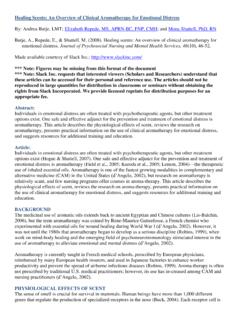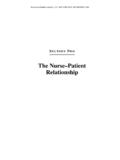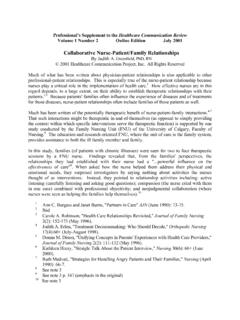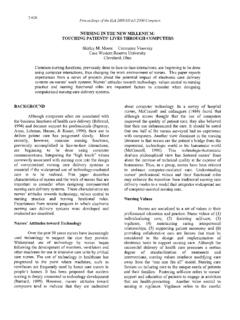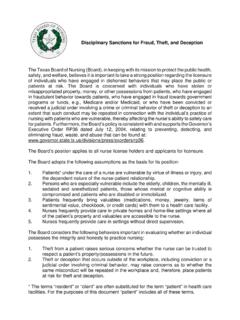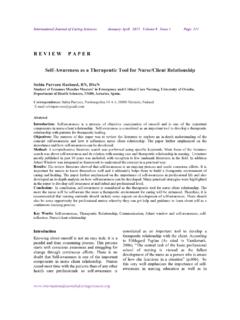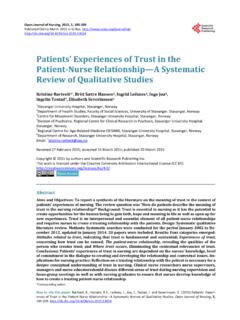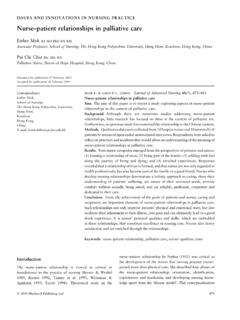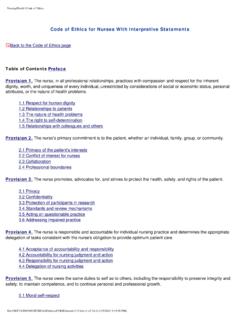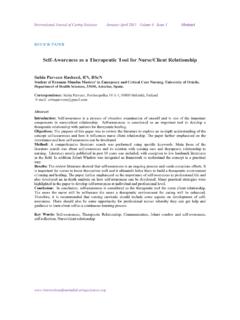Transcription of Nurse patient interaction: a review of the literature
1 Nurse patient interaction: a review of the literature By: Mona Shattell Shattell, M. (2004). Nurse - patient interaction: a review of the literature . Journal of Clinical Nursing, 13, 714-722. Made available courtesy of Blackwell Publishing. The definitive version is available at **Note: Figures may be missing from this format of the document Abstract: Aims. The aims of this paper are to review a theoretical model useful for developing nursing knowledge related to Nurse patient interaction, review the literature on Nurse patient interaction, and discuss areas for further research. Theoretical model. Goffman s theory of face work. Results. Nurse patient interaction is a central element of clinical nursing practice.
2 This paper shows how Goffman s model can be used as a theoretical framework for understanding Nurse patient communication. Relevance to clinical practice. Issues such as power, the social and cultural context, and interpersonal competence are shown to be important in the quality of Nurse patient interactions and nurses need to take cognizance of these factors in their interactions with patients . Key words: Nurse patient communication, Nurse patient interaction, Nurse patient relationship Introduction Article: Society views nurses favourably, often as benevolent, virtuous and admirable. Nurses have been positively stereotyped as ministering angels or angels of mercy (Muff, 1982).
3 Nurses frequently experience this positive view of the profession first hand in clinical practice. How often have you heard statements such as these? They [the nurses] are so nice , Oh, honey, you are so sweet , you are the best Nurse , the nursing staff is very nice . Nurses reading this paper will probably be familiar with nurses stations overflowing with candies and treats that have been sent from appreciative patients and/or their families. An existential phenomenological study of the hospital environment found that nurses were prominent in patient s descriptions of the hospital (Shattell, 2002). Participants in Shattell s (2002) study were asked what they were aware of in the hospital environment.
4 In addition to positive statements about nice nurses , strong negative statements about nurses and nursing care were also present in their descriptions of the hospital environment. One participant who was hospitalized on an oncology unit said this of her hospitalization and of the nursing staff collectively: It s terrible [the radium implant]. So finally I thought okay, endure this, we ll get through it. And heck with it and I ll get through the next one and of course I didn t want to come back here. I mean this time when I had surgery, I mean I knew I had to come back up here and I thought, I hate them, and they hate me [italics added] (unpublished raw data). The patients views of nurses illustrated above clearly demonstrate a paradox.
5 These patients overall experiences of their nursing care appear inconsistent with their initial representation of the nice Nurse . While nurses may be seen as nice , patient participants in Shattell s (2002) study of the hospital environment longed for more and deeper connections with nurses. They experienced the hospital environment as disconnecting and actively sought ways to connect with nurses. patient s dependence on nursing staff as well as perceived powerlessness to the Nurse s power, created a situation where patients believed they had actively to find ways to solicit needed nursing care. In addition to these factors, nurses were viewed as overworked and over-whelmed, leading to even greater patient needs and hence, more active strategies to get these needs met.
6 Nurse patient interaction was central to this tactic. The aim of this paper is to review a theoretical basis for nursing knowledge development for Nurse patient interaction, review the literature on Nurse patient interaction, and discuss areas for further research. Goffman s theory of face work will be reviewed followed by a review of the literature categorized into the following subgroups: Nurse communication within Nurse patient interaction, Nurse patient interaction, patient perception of Nurse patient interaction, and patient care-seeking communication. Following the literature review will be a discussion including implications for practice and future research. Goffman s theory of face work Nurse patient interaction can be conceptualized from the theoretical perspective of symbolic interactionism.
7 Symbolic interactionism is a philosophical perspective that originated from George Herbert Mead in the early 1900s at the Chicago School , specifically, the Department of Sociology at the University of Chicago. Symbolic interactionism is a social psychological approach to studying the meaning of human action (Schwandt, 1998). Accordingly: A person s sense of self emerges through social a sense of self develops as people (a) imagine themselves in other social roles (seeing themselves as through the eyes of others and internalizing the attitudes of the generalized other), (b) anticipate the responses of others, and (c) act in accordance with the meaning that things (other people, ideas, events, objects, or situations) have for them (Powers & Knapp, 1995, pp.)
8 166 167). In other words, the individual interprets the environment based on symbols and meaning and then acts accordingly. Symbolic interactionism views human-to-human interaction not according to response and stimulus but through interpretation, and meaningful and purposeful action and interaction. Goffman s theory of face work, consistent with symbolic interactionist thought, describes a theory of interaction whereby both individuals interpret and act in order to maintain the face of self and other. An individual presents to the other with a particular evaluation of how the self is to be portrayed. Goffman (1955) coined the term face work to describe the interaction ritual in human-to-human encounter.
9 He defined the term face as the positive social value a person effectively claims for himself [sic] by the line others assume he has taken during a particular contact (Goffman, 1967, p. 5). A line can be described as a front, which is presented through verbal and non-verbal behaviour that conveys the individual s appraisal of both participants, especially of him/herself. A purpose of the face work is to manage the impressions, or face, of both self and other. This management of impressions of and by self and others were described in terms of a theatrical performance (Goffman, 1959). Goffman (1967) theorized that people interacted in a cooperative dance. Participant s descriptions simultaneously representing nurses as both nice and cold and distant, demonstrate the patients contradictory accounts of their relationships with nurses (Shattell, 2002).
10 The coexistence of two opposing views of nurses can be considered through face work theory. The patient s use of flattery may be an attempt to maintain the face of self and other in the care-giving/care-receiving interaction. The patient strives for a favourable impression by the Nurse , simultaneously attempting to maintain self-esteem and autonomy. Spiers (1998) advocates the use of face work theory in nursing research on Nurse patient communication as current communication theories used by nursing (stemming from the discipline of psychology) are inadequate fully to explain how communication is directed by basic human and cultural needs (p. 25). The use of face work theory can: illuminate how communication in interaction is negotiated and mutually constructed and how specific verbal strategies function in multiple ways to respond to the instrumental demands of the situation as well as the interpersonal needs of both participants (Spiers, 1998, p.)





